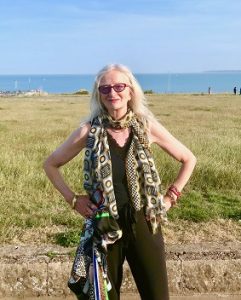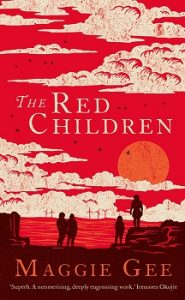On Growing Your Novel: Magical Gifts on Real-life Trees
 The going always gets hard at some stage of writing a novel – at least, it always has for me. And then the main thing is not to give up. My new novel, The Red Children, out this April, is my seventeenth book and in a way the one I love best, partly because I’ve tried to put into it everything I’ve learned about life.
The going always gets hard at some stage of writing a novel – at least, it always has for me. And then the main thing is not to give up. My new novel, The Red Children, out this April, is my seventeenth book and in a way the one I love best, partly because I’ve tried to put into it everything I’ve learned about life.
The Red Children is a fable or fairy tale for adults, a story of refugees, deep history and the value of kindness that’s a mere 80,000 words long. Because it’s a comedy, ie ‘a book with a happy ending’, unlike The White Family (the 20th anniversary edition, with introduction by Bernardine Evaristo, is published at the same time), it might at first seem like a lighter or easier book to write. Yet it has taken nine years from start to finish, I’ve nearly given it up at least once and I have written and published two other books while it was on the long road to completion.
Though writers always say that hard work is the only answer to getting books out (and we’re right to say it, because nothing happens without an immense amount of hard work) we should not underrate the role of happenstance – the unexpected arrowing in from the wings. This is why I tell young writers to go out of the house and do research, not just to depend on Google. Outside the protective skin of our own mental and physical bubble, new things and people and thus new ideas and motifs implode into our bodily consciousness, and in my experience, bring the gift of radical changes to a book. Only my husband, daughter and closest friends know how often I blend material that has happened to me into my fiction, disguised and re-modelled.
One of the surprising things about The Red Children is the arrival of four naked strangers, red from exposure, laughing, on Ramsgate harbour quay early one spring morning in the future. They ‘don’t look quite human’, people opine. Yet they are. They are, in fact, Neanderthals, refugees from the caves where, in my fable, they have survived deep under the earth for more than 35,000 years. But now the world is heating up and excessive commercial development is threatening their homes. A few at a time at first, then in increasing numbers, they flee towards the cooler north and the future. The indigenous population, at first astonished and afraid of them, quite soon starts to learn from them. (And in actual fact it is quite true that Neanderthals survived at least three times longer than homo sapiens like us have managed to date.) Are we really cleverer than them, then? Or should we be learning from their lower tech ways of living and being happy?
Serendipity helped me twice. My ideas benefited enormously from the real-life research into Neanderthals of Professors Clive and Geraldine Finlayson, who I was lucky enough to meet – pure serendipity, I went to the launch of one of their books – in Gibraltar back in 2012. They were at the forefront of discoveries subsequently popularised about the intelligence, social lives and material culture of Neanderthals, whose name was until relatively recently used as a synonym for ‘brutish, aggressive, macho’ in something analogous to the insulting simplifications of racism. In 2013 I decided to rewrite the Neanderthals in fiction in Gibraltar, and in their own time. But how would I render their language? And did I have the skills to recreate deep time, given that all my books have been set in the present or future? Despite all my research, the project sat unfinished in my laptop.
Time for the second bit of serendipity – lockdown 2020. Forced to stay home in Kent, I fell in love all over again with our coast, its long sands, its palm trees and caves, its views across the sea to Cap Gris Nez in France at sunset, its naval history and its bird life, including crows and ravens, those cleverest of birds. I loved the way the Thanet views that JM Turner painted opened out across the glittering sea into a world that was temporarily forbidden us. I remembered that most of Britain’s invaders, including Julius Caesar, landed near us in Ramsgate – migrants were in no way a new phenomenon here. I discovered that Neanderthals had lived in Kent, too. And suddenly I saw how like Ramsgate was to Gibraltar – sea, caves, palms, ravens. Why shouldn’t the Neanderthals come back again, in our near future? I couldn’t travel to Gibraltar, but Neanderthals could travel in my imagination to me. And thus suddenly the infant book woke up from its long sleep, yawned, stretched, and said ‘I’m here! I’m alive! Feed me!’ Writing a book really is not unlike having a child – it takes so much longer than you ever thought when you first got a gleam in your eye, and they never come out quite like you thought they would.
The first image of a book, for me, has always been like a tiny, immensely-detailed, jewel-bright, stained-glass window in the far distance – mysterious and so attractive that I can’t wait to get started down the long road towards it. However it’s always further away than I think, and the road sometimes peters out or mires me in mud. What to do then? I hang on to the hope I will arrive one day, but meanwhile, I strike out across country, keeping a look out for magic gifts hanging at random on trees like the twin fruit dangling from London plane trees – in folklore these are wooing gifts left by a king for his love.
I love The Red Children more, I think, because writing it cost me more, and because serendipity – the magic of the world, we could call it – saw my need and flew in at an angle to help me. The Surrealists called this ‘hasard objectif’: if you look at the world with desire, your wish will be answered. I would say that if you love and trust the amazing world out there, you will discover it is constantly offering you stories. Best of luck along the road.
—
The Red Children, Telegram, hardback £14.99.
The White Family, 20th anniversary edition with introduction by Bernardine Evaristo,Telegram, £9.99.
THE RED CHILDREN
 It’s the 2030s in Ramsgate and four people who don’t look quite human are found sitting, naked, in the early spring sunlight on the quay of the quiet south coast resort. The locals are puzzled – the newcomers are larger and heavier than they are and say they are fleeing the heat. Soon more arrive. Their tall red-haired leader, The Professor, talks to the universe. The locals talk among themselves.
It’s the 2030s in Ramsgate and four people who don’t look quite human are found sitting, naked, in the early spring sunlight on the quay of the quiet south coast resort. The locals are puzzled – the newcomers are larger and heavier than they are and say they are fleeing the heat. Soon more arrive. Their tall red-haired leader, The Professor, talks to the universe. The locals talk among themselves.
Red people appear everywhere, making friends, going into the caves, liked by some but accused of bringing infection by others. Two rivalrous brothers, Liam and Joe, take different sides as one joins a notorious far-right group. Their teacher Monica is the first to warn there’ll be trouble. And she’s right, there is; but there is also a great Midsummer Festival, laughter and love.
Set in a world in crisis, this original, gripping fable about migration and global warming restores belief in the power of human kindness.
—
About the Author
Maggie Gee is the author of seventeen critically acclaimed books, which have been translated into more than fifteen languages. These include the novels The Red Children, My Cleaner and The White Family (shortlisted for the Orange Prize for Fiction and International IMPAC Dublin Literary Award), and a memoir, My Animal Life. Gee is a Fellow and Vice-President of the Royal Society of Literature and Professor of Creative Writing at Bath Spa University. She was awarded an OBE in 2012 for her services to literature.
Reviews
‘A stylish, intriguing novel. A fable bursting with freshness and foresight, a charming, sparkling jewel of a novel to be cherished and held high as an antidote to modern day bleakness and climate despair.’
Leila Aboulela
‘The Red Children offers a warning and a vision of our past, present and future. This timely, vital and generous book is extraordinary in its courage, and hopeful and brutally honest in its clarity. An essential book for our times.’
Salena Godden
‘Superb. A mesmerising, deeply engrossing work.’
Irenosen Okojie
Category: How To and Tips























